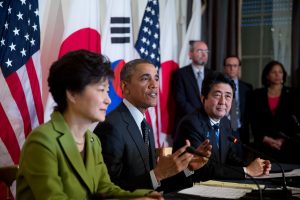CNN’s national security analyst Peter Bergen recently published an op-ed on the significance of the Afghan national unity government’s decision to allow a continued U.S. troop presence in Afghanistan after the end of this year. Bergen clearly sees this as a good thing. In fact, he sees it as a great thing, because a U.S. security guarantee is a sufficient condition for economic growth. The analogy? South Korea.
The line in question reads: “At the end of the Korean war in 1953 South Korea was one of the poorest countries in the world; now, under an American security umbrella, it is one of the richest.” Never mind Korean economic planning, Japanese loans, the Economic Planning Bureau, or other equally if not more important factors. It’s a fanciful statement that lays bare a U.S.-centric understanding of the world prominent among many influential Americans — like Bergen. In his defense, the line isn’t much more than a throwaway nestled at the end of a short op-ed. So, rather than throw it out, let’s indulge it. With the publication of the CRS report on the Korea-U.S. Free Trade Agreement, now is as good a time as ever to think about U.S.-South Korea relations and the U.S. role in East Asia.
The U.S. has had a huge security and economic presence on the Korean peninsula and in the broader region for more than fifty years. After World War II, the U.S. established a network of bilateral alliances with strategically located countries in the Asia Pacific, including Taiwan, Japan, and South Korea. The hub and spokes-like alliance architecture built by the U.S. is commonly referred to as the “San Francisco System.” Victor Cha, in his article “Powerplay: The Origins of the U.S. Alliance System in East Asia,” argues that the U.S. pursued a network of asymmetric bilateral alliances that would give it power to control the actions of its (smaller) allies and prevent “rogue allies” (e.g., Chiang Kai-shek) from starting a unwanted war. But there was more to it than just security commitments. As Kent Calder argues, the postwar security architecture was underwritten by U.S. economic strength. In exchange for security cooperation with the U.S., the “spokes” had an export market.
The economic footing of this system has shifted; in the era of America’s (relative) decline and China’s rise, it was inevitable that the structures of foreign trade for the export-oriented countries of Taiwan, Japan, and Korea would change. Regardless, much of the logic that drove postwar policy still mainly drives policymaking today.
Take, for instance, the Korea-U.S. Free Trade Agreement (KORUS FTA). As scholars Sohn Yul and Koo Min-gyo argue, the KORUS FTA “clearly shows how countries simultaneously pursue economic benefits and strategic interests in trade negotiations.” KORUS FTA negotiations made clear the security implications of the free trade agreement, what Sohn and Min describe as “joint efforts… to re-securitize” the U.S.-Korea bilateral relationship. In short, the U.S. continues to use trade as a means to advance broader strategic goals. The most recent Congressional Research Service report on the KORUS FTA, released last month, reinforces this point. The authors of the report write:
“President Obama, Secretary of State Hillary Clinton, and other U.S. officials have said that the KORUS FTA, along with the TPP, are key parts of their move to ‘rebalance’ U.S. strategic orientation toward the Asia-Pacific, in that they are designed to help shape the economic rules that will govern the region’s economic activity in the coming decades.”
The notable difference in the logic is that a multilateral strategy is now seen as viable; this isn’t at all surpiring given the shifting geopolitical landscape and a more connected global economy.
While we can see that the U.S. still uses a logic of securitized trade, we ought not to forget that South Korea, too, has a strategy of its own: securing free trade agreements with its largest economic trading partners, China included. Going forward, it will be interesting to watch how South Korea plays to its strengths and navigates the space in between the world’s two largest economies while the U.S. continues to use economic ties and trade for strategic ends.

































